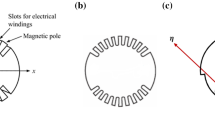Abstract
The Hopf and double Hopf bifurcations analysis of asymmetrical rotating shafts with stretching nonlinearity are investigated. The shaft is simply supported and is composed of viscoelastic material. The rotary inertia and gyroscopic effect are considered, but, shear deformation is neglected. To consider the viscoelastic behavior of the shaft, the Kelvin–Voigt model is used. Hopf bifurcations occur due to instability caused by internal damping. To analyze the dynamics of the system in the vicinity of Hopf bifurcations, the center manifold theory is utilized. The standard normal forms of Hopf bifurcations for symmetrical and asymmetrical shafts are obtained. It is shown that the symmetrical shafts have double zero eigenvalues in the absence of external damping, but asymmetrical shafts do not have. The asymmetrical shaft in the absence of external damping has a saddle point, therefore the system is unstable. Also, for symmetrical and asymmetrical shafts, in the presence of external damping at the critical speeds, supercritical Hopf bifurcations occur. The amplitude of periodic solution due to supercritical Hopf bifurcations for symmetrical and asymmetrical shafts for the higher modes would be different, due to shaft asymmetry. Consequently, the effect of shaft asymmetry in the higher modes is considerable. Also, the amplitude of periodic solutions for symmetrical shafts with rotary inertia effect is higher than those of without one. In addition, the dynamic behavior of the system in the vicinity of double Hopf bifurcation is investigated. It is seen that in this case depending on the damping and rotational speed, the sink, source, or saddle equilibrium points occur in the system.















Similar content being viewed by others
References
Vatta, F., Vigliani, A.: Internal damping in rotating shafts. Mech. Mach. Theory. 43(11), 1376–1384 (2008)
Khadem, S.E., Shahgholi, M., Hosseini, S.A.A.: Two-mode combination resonances of an in-extensional rotating shaft with large amplitude. Nonlinear Dyn. 65(3), 217–233 (2011). doi:10.1007/s11071-010-9884-2
Lewis, D.M.: Stability of whirling shafts with internal and external damping. Int. J. Non-Linear Mech. 8(2), 155–160 (1973)
Genin, J., Maybee, J.S.: The role of material damping in the stability of rotating systems. J. Sound Vib. 21(4), 399–404 (1972)
Dasgupta, S.S., Samantaray, A.K., Bhattacharyya, R.: Stability of an internally damped non-ideal flexible spinning shaft. Int. J. Non-Linear Mech. 45(3), 286–293 (2010)
Avramov, K., Borysiuk, O.: Nonlinear dynamics of one disk asymmetrical rotor supported by two journal bearings. Nonlinear Dyn. 67, 1201–1219 (2012). doi:10.1007/s11071-011-0063-x
Chouksey, M., Dutt, J.K., Modak, S.V.: Modal analysis of rotor-shaft system under the influence of rotor-shaft material damping and fluid film forces. Mech. Mach. Theory 48, 81–93 (2012)
Xu, X., Wiercigroch, M.: Approximate analytical solutions for oscillatory and rotational motion of a parametric pendulum. Nonlinear Dyn. 47(1), 311–320 (2007). doi:10.1007/s11071-006-9074-4
Ganesan, R.: Effects of bearing and shaft asymmetries on the instability of rotors operating at near-critical speeds. Mech. Mach. Theory 35(5), 737–752 (2000)
Genin, J., Maybee, J.S.: Whirling motion of a viscoelastic continuous shaft. Int. J. Eng. Sci. 8(8), 671–686 (1970)
Samantaray, A.: Steady-state dynamics of a non-ideal rotor with internal damping and gyroscopic effects. Nonlinear Dyn. 56(4), 443–451 (2009). doi:10.1007/s11071-008-9413-8
Quinn, D.: Resonant dynamics in a rotordynamic system with nonlinear inertial coupling and shaft anisotropy. Nonlinear Dyn. 57(4), 623–633 (2009). doi:10.1007/s11071-009-9502-3
Arora, H.L., Arora, K.L.: On the asymptotic stability of the solution of a linear viscoelastic continuous shaft. Int. J. Eng. Sci. 13(11), 905–913 (1975)
Ikeda, T., Murakami, S.: Dynamic response and stability of a rotating asymmetric shaft mounted on a flexible base. Nonlinear Dyn. 20(1), 1–19 (1999). doi:10.1023/a:1008302203981
Shaw, J., Shaw, S.W.: Non-linear resonance of an unbalanced rotating shaft with internal damping. J. Sound Vib. 147(3), 435–451 (1991)
Shahgholi, M., Khadem, S.: Stability analysis of a nonlinear rotating asymmetrical shaft near the resonances. Nonlinear Dyn. 70, 1311–1325 (2012). doi:10.1007/s11071-012-0535-7
Chang, C.O., Cheng, J.W.: Non-linear dynamics and instability of a rotating shaft–disk system. J. Sound Vib. 160(3), 443–545 (1993)
Yamamoto, T., Ishida, Y.: Linear and Nonlinear Rotordynamics. Wiley, New York (2001)
Nayfeh, A.H., Balachandran, B.: Applied Nonlinear Dynamics. Wiley, New York (2004)
Perko, L.: Differential Equations and Dynamical Systems. Springer, New York (2001)
Guckenheimer, J., Holmes, P.: Nonlinear Oscillations, Dynamical Systems, and Bifurcations of Vector Fields. Springer-Verlag, New York (1986)
Author information
Authors and Affiliations
Corresponding author
Appendix
Appendix
Rights and permissions
About this article
Cite this article
Shahgholi, M., Khadem, S.E. Hopf bifurcation analysis of asymmetrical rotating shafts. Nonlinear Dyn 77, 1141–1155 (2014). https://doi.org/10.1007/s11071-014-1367-4
Received:
Accepted:
Published:
Issue Date:
DOI: https://doi.org/10.1007/s11071-014-1367-4




